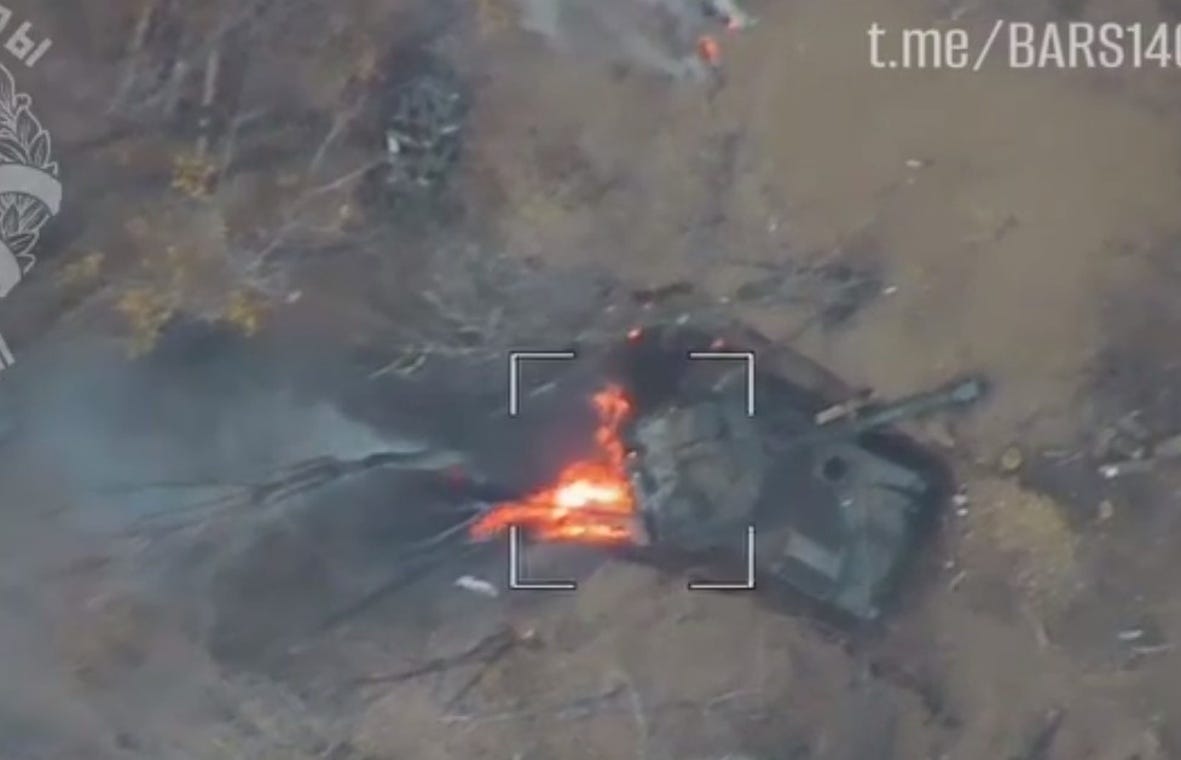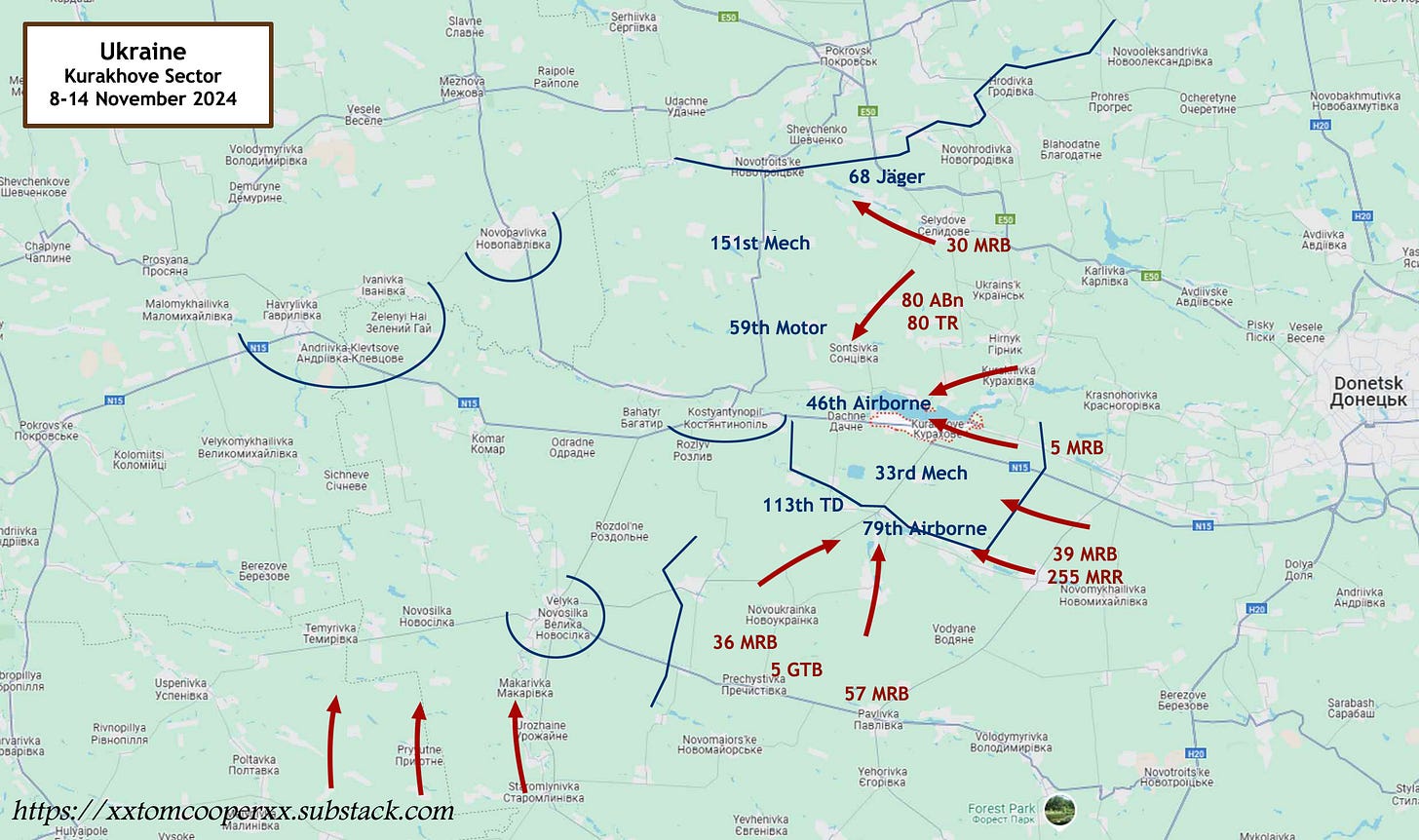Hello everybody!
A quick update that was not originally planned - and then one focusing on few ‘hot-spots’ of the battlefields in Ukraine.
***
Kupyansk-Svatove…
Yesterday as I was writing my last ‘update’, news came in about a major Russian attack on Kupyansk. Took some time to find out what exactly is going on: eventually, it turned out that following a series of air strikes (partially by UMPKs, partially the ‘spray & pray’ style), and a massive artillery barrage on Kupyansk, the Russians attacked from the north - along the railway berm from Syrkivka, and then over the partially collapsed bridge on the Hnylytsya River - and managed to actually reach the northern side of the town. How far they’ve got is confirmed by the destruction of this MT-LB armoured personnel carrier, actually inside Kupyansk (by an FPV).
Was quite a feat: not only breaching the Ukrainian frontline, but then driving down for at least 5km deep behind the Ukrainian lines…
AFAIK, it was 116th Mech (ZSU) that counterattacked as first, and it seems it did manage to smash the Russian assault group as this has entered the town, the last evening. However, reports are indicating that the situation is ‘remaining hot’: the Russian air strikes and artillery fire remain exceptionally heavy, and additional Russian assault groups have followed down the railway berm through the afternoon and the evening. They seem to have secured a wide bridgehead south of the Hnylytsya (can’t repeat it often enough: mind ‘that’ with ‘the Russians and bridgeheads’), and then embedded themselves east and west of the railway berm, all the way down to what appears to be a former fishery farm, north of Kupyansk.
The latter is consisting of a complex of berms surrounding about three dozens of ponds. Sure, the soil inside these ponds is ‘largely dry but actually swampy’. However, it’s the berms that are providing plentiful of protection for the Russian troops. It’s like if they’ve constructed an elaborate complex of trenches (and, they’re certainly going to expand the resulting ‘system of fortifications’ in the coming days).
Reminds me there was a similar situation - or at least similar terrain - in the Faw Peninsula of southern Iraq, back in February 1986: by night and pouring rain, the Iranians have crossed the Shatt al-Arab, and then seized a ‘salt farm’ north of al-Faw. This also consisted of a system of berms, dykes, and ponds. Long story short: the Iraqis didn’t manage to dislodge them from there for the next two years, regardless of their almost complete superiority in the air, wast supremacy in artillery, and losing nearly a dozen of brigades in troops while counterattacking. The Iranian assault and then months-long Iraqi counterattacks nearly broke the back of the Iraqi Army… What eventually ‘worked’, in April 1988, was massive deployment of chemical weapons… And since the Ukrainians are not deploying these, and they remain short on artillery shells… well, I’m sure you can figure out the rest.
How could this happen?
There are several factors. First is that of ‘railway berms’. Like in Ocheretyne back in April, and for weeks and months after (all the time while they were approaching Pokrovsk), the Russians managed to punch through by advancing along a railway berm. Railway berms are consisting of compressed soil and gravel, and thus are very hard to mine. Like in the Ocheretyne area, the ZSU obviously neither mined nor emplaced obstacles along this one, nor did it care to blow up the berm in multiple places, so to make it inpassable for vehicles. And then, the Russians are scouting by UAVs, and probing by Spetsnaz for weeks (for months, if necessary) until they know where are Ukrainian positions guarding such a ‘way’, where are minefields, where are clear lines through minefields: they infiltrate at night, overpower the guards and then punch through.
Overall: sorry that I was right, back in March. The Russians know that if they want Lyman, and Slovyansk, they have to recover Kuypansk first. Sure, they can’t realise all of their plans (for example; the Chasiv Yar Axis didn’t work this year), but - and, as much as the Keystone Cops remain incompetent and lacking ideas - they always have a master-plan, and a check-list. One can always count on them to faithfully follow these, in ‘point-by-point’ fashion.
***
Pokrovsk-Kurakhove…
This one is also ‘developing along the (Russian) plan’: essentially, the Group Tsentr, VSRF, is keeping the 46th Airborne in Kurakhove busy, while trying to deep-flank it - plus the 33rd Mech and the 79th Airbrone - via Sontsivka in the north and, that’s the latest development, via Trudove and Uspenivka in the south.
No doubt, all three of Ukrainian brigades are fighting fantastically (and fanatically, too). And the 59th Motor’s counterattack into Sonsivka was semi-successful, after all: the brigade has managed to stop the Russian advance in the northern side of that village. However, writing is on the wall - as obvious from the Russians securing Voznesenka and Novoselydivka, plus entering Beretsky, north of Kurakhove, yesterday, and by continuing to push into Dalnie, south of Kurakhove. Especially since some idiot within the ZSU ordered the mining of the Kurakhove Dam, in turn draining the Vovotcha Lake - thus opening a wide gap in the lines of the 46th Airborne (with other words: yes, whoever is still insistent on ‘the Russians blew up the Kurakhove Dam’, is simply clueless… at least covering-up yet another mistake within ranks of Ukrainian commanders).
Sure, much of other Russian advances are possible thanks to severe air strikes, lots of FPVs, and massive artillery barrages, which - and there’s no doubt for this, at least in the case of this battle - are causing losses to the ZSU. Here’s one example, a M109 of the 33rd Mech, knocked out by a Lancet:
This Leo2 was also hit and abandoned - but at least some 1,000m behind the Ukrainian lines: gives hope the 33rd might be able to recover it intact, for repairs.
Less lucky was this T-72M of the 79th airborne: it was hit and abandoned, and then set afire while covering the withdrawal of elements of that brigade from the Romanivka-Yeyzavetivka area.
What’s more, now the fate of a better part of the 79th Airborne is dependent on what I’m calling the ‘113rd TD’ - which is actually some 6-7 disparate and depleted battalions from entirely different brigades, rushed by Syrsky (much too late) to patch up the southern sector of the frontline after the Russians seized ruined Vuhledar.
EDIT: forgot to draw your attention at the VSRF units assaulting the Kurakhove area from the south. For example: the 5th (Guards) Tank Brigade. Sure, not a particularly famous unit, and then one of many that had to be completely re-built following the battle of Izyum, in March 2022. However, ever since, it’s one of ‘most soberly/reasonably-commanded’ Russian units in this war. The 36th Motor-Rifle Brigade is also a ‘decent’ unit: no ‘kamikaze infantry’ with ridiculous commanders like the 155th and 810th Naval Infantry Brigades. The two worked very well together during the final assaults on Vuhledar.
BTW, south-west from Kurakhove, the Russians are assaulting on a wide frontline in the Velyka Novosilka area, too. Word is, the area is meanwhile defended by most of the 128th Mountain Assault (minus its sole Motor-Rifle Battalion: the one nearly-destroyed at Shakhtarske, back in late October): that, plus plentiful of minefields left over from the campaigns of 2023, is making it at least ‘likely’ that the ZSU frontline in this area might hold out.










Tom, if you don't mind, I'll post an important collection of 60 million UAH for 30,000 anti-tank PTM-3, the needs of 80 brigades of the Armed Forces of Ukraine.
Own production of sugar by 414th OPUBAS.
The video contains a detailed report on the expenditure of funds from the October collection, production and distribution of candy among the JFO forces.
Please spread the word and join the fundraiser as much as you can.
Here is a link to the Magyar telegram channel, where all the details are presented.
https://t.me/robert_magyar
Thank you in advance to everyone who donates. There are many units where my friends and relatives are.
Thank you. Another good update.